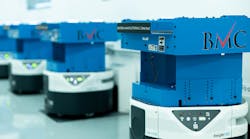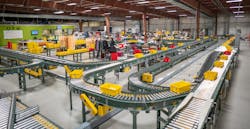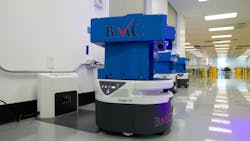Clothing Manufacturer Triples Production Capacity with Autonomous Mobile Robots
If you don’t bolt conveyor belts to the floor and instead let autonomous mobile robots (AMRs) handle material transport, you might have a lot more room in your plant to manufacture product.
So discovered Bespoke Manufacturing Company (BMC), an on-demand manufacturer of clothing and home goods.
BMC President and CEO J. Kirby Best refers to the plant in Phoenix, Arizona, as a “one-off mass customization facility.” BMC’s business model minimizes human contact: Designers create outfits on the iCreate.Fashion website that then packages the design files into a format readable by BMC’s automated clothing press and digital cutting equipment.
BMC employees take the pressed and cut clothing components, usually seven pieces for a dress, for example, and place them into a barcoded tote. An employee places the appropriate zippers, buttons, etc. into the tote and loads it onto an AMR.
AMRs then deliver totes between as many sewing stations as required and deliver finished products to inspection and packaging stations. As barcode scanners register the totes at each location, the plant’s M3 computer system tracks the positions of every garment in the plant. The loop removes humans completely.
“If I have one big bugaboo about working in factories it’s trying to let people think and let computers handle everything else that doesn’t require real thought,” Best says. “I need humans thinking about things that robots can’t solve.”
Best also cites an expression in the clothing business.
“If you touch it, you’ve lost money.”
Realizing When Technology Gets Old
The plant at Best’s previous company, on-demand clothing manufacturer OnPoint Manufacturing, featured extensive automation and made liberal use of conveyor belts. “It sounds ridiculous, but there’s a real art to conveyor belts and getting them to work well,” Best says.
The plant’s computer systems and PLCs weren’t up to the task of tracking all the totes as they moved through the conveyor system, which led to garments getting caught in transit and delayed production. For example, totes shunted to sewing stations off a 750-foot conveyor loop, like a car getting off an exit on a roundabout.
“Once a tote gets on that loop, it has one chance of being picked up and sent off to go to a sewing machine. If there’s a misread… it’s going to go around another 750 feet,” Best says. “If that sewing station is full, it’s going to go around again another 750 feet. We found totes were circling three days on this loop.”
The 1,500 feet of conveyor belts at the OnPoint Manufacturing plant also took up a tremendous amount of floor space. They were bolted down, making it onerous to refine the floor layout. Best decided that at his next plant he wasn’t going to hamstring himself with conveyors and try robots, instead.
Herding AMRs
The ideas that Best developed for OnPoint’s second plant instead formed the basis of his plans for the BMC plant. AMRs were in the offing from day one.
Best considered three companies to provide the plant’s AMRs. Key considerations included the operating space required by different robot models, their safety functions, length of battery life and ease of expanding the fleet in the future. Best ultimately chose Fetch Robotics Inc., part of Zebra Technologies [read more here about Zebra executive Melonee Wise’s groundbreaking works on robotic behavior].
As a greenfield facility, the plant’s floor plan could account for AMR traffic from the beginning and Best thought the floor plan left adequate room for the AMRs to operate. Optimal pathing isn’t just about leaving room for the robots, however.
“We weren’t sophisticated enough to know the right questions to ask,” Best says. “[Fetch] warned us right off the bat that we should consider a single path rather than two-way streets. And I, in my pigheaded method, said ‘No, that makes no sense to me whatsoever. If they operate the way that you tell me they operate, then a two-way street should work perfectly.’”
Best, who skied on Canadian national ski teams in the early 1980s, refers to the result of deploying AMRs on two-way streets as “a Canadian traffic jam.”
The AMRs feature collision avoidance safety systems and stop moving when objects, including other AMRs on the other side of a two-way street, cross their path. Once in safety mode, an AMR waits for its path to clear before resuming travel. Traffic jams resulted because AMRs, like Canadians that are overly polite at roundabouts (according to Best) constantly defer to each other to move first and clear the jam.
Ongoing construction also literally provided obstacles to setting up AMR pathing.
“It became a real challenge for the guys at Fetch because they’d get a good, clear pathway and then they’d come in the next morning and a transport truck had [delivered] five new machines [that were] now in their clear pathway,” Best says. He adds that in the future, he wouldn’t bring in his AMR team until completing 95% of construction and installation.
The M3 system tracks AMR pathing and monitors routes for efficiency. BMC employees can make simple adjustments. More complicated corrections require experts from Fetch. Best admits he could have obviated some of these pathing issues from the very beginning.
“There’s a bit of a chicken and egg [situation] but you should have it narrowed down [during floor planning] and then when you start getting into ’This is how I want to lay it out,’ you have to have your AMR team with you because you’re hand in hand at that stage,” Best says. “Today, I would bring them in much earlier and have them much more integral in that planning process.”
Best never had to worry about employee buy-in because 85% of his employees run sewing stations and he sees no machines on the horizon that could viably take these employees’ jobs away, especially in the one-off, on-demand clothes manufacturing industry. The highly regulated AMRs also present no safety concerns.
More Space Equals More Product
With the factory in full operation and 120 sewing stations in use, the facility’s M3 computer system, every seven seconds, calculates where to direct each AMR based on the type of seam an operator sews, the materials loaded into their machine and their relative skill among other variables.
Best says that 10 of the factory’s AMRs are usually in motion simultaneously and the M3 system can at any time adjust any AMR’s intended location, based on how variables change.
“We can redirect a tote in the middle of the process to help out with the load leveling of the factory,” says Best.
Thanks to replacing the conveyor system with the AMR fleet, the plant enjoys a 33% improvement in space efficiency and has much more room for sewing equipment. According to Best, this tripled the production capacity of his previous plant at OnPoint Manufacturing.
“I am convinced, today, I could probably get another 30% increase in the next plant we’re building,” Best says.
About the Author
Dennis Scimeca
Dennis Scimeca is a veteran technology journalist with particular experience in vision system technology, machine learning/artificial intelligence, and augmented/mixed/virtual reality (XR), with bylines in consumer, developer, and B2B outlets.
At IndustryWeek, he covers the competitive advantages gained by manufacturers that deploy proven technologies. If you would like to share your story with IndustryWeek, please contact Dennis at [email protected].




